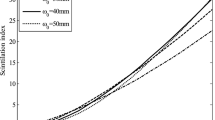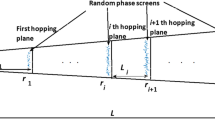Abstract
The scintillation index (SI) is an important issue in studying the effect of the atmospheric turbulence in the light waves. With the Rytov weak fluctuation theory, the SI is commonly referred to the Rytov parameter. The previous studies dealt with the plane wave and spherical wave models. Each of these gives an idea of how an optical beam will react to turbulence but are not realistic. One is infinitely long, while the other is an infinitesimal point source. The Gaussian beam wave is the most realistic of the optical waves, but also the most complex to use for calculations. In this paper, a closed form expression for Gaussian beam SI propagation in slant path and through weak fluctuation is derived using the polynomial model of the refractive index structure parameter. The slant path SI model of the plane and spherical waves can be generated from the SI expression of Gaussian beam. The analytic expressions are obtained and are then used to analyze the effect of propagation distance, transmitter/receiver heights, and elevation angle on the SI. Signal to noise ratio and bit error rate are calculated for performance evaluation showing a significant enhancement at elevation angles greater than 45°.







Similar content being viewed by others
References
Andrews, L.C., Phillips, R.L.: Laser Beam Propagation Through Random Media, 2nd edn. SPIE Press, Washington (2005)
Andrews, L.C., Phillips, R.L., Hopen, C.Y.: Laser Beam Scintillation with Applications. SPIE, Bellingham (2001)
Ata, Y., Baykal, Y.: Effect of anisotropy on bit error rate for an asymmetrical Gaussian beam in a turbulent ocean. Appl. Opt. 57(9), 2258–2262 (2018)
Cheng, M., Guo, L., Li, J.: Influence of moderate-to-strong anisotropic non-Kolmogrov turbulence on intensity fluctuations of a Gaussian–Shell model beam in marine atmosphere. Chinese Physics B 27(5), 054203 (2018)
Cui, L., Xue, B., Xue, W., Bai, X., Cao, X., Zhou, F.: Expressions of the scintillation index for optical waves propagating through weak non-Kolmogorov turbulence based on the generalized atmospheric spectral model. Opt. Laser Technol. 44, 2453–2458 (2012)
Fayed, H.A., Aziz, A.A.E., Aly, A.M., Aly, M.H.: Irradiance scintillation index on slant atmospheric turbulence: a simple approach. Opt. Eng. 55(5), 056113 1–056113 8 (2016)
Feng, J., Yuan, Y., Zahou, Z., Qu, J.: Beam wande of multi-Gaussian shell-model hermite-Gaussian beam in atmospheric turbulence. In: The 39th PIERS, Progress in Electromagnetics Research Symposium-Fall (PIERS-FALL), Singapore, pp. 311–316, 19–22 Nov. 2017
Ghassemlooy, Z., Popoola, W., Rajbhandari, S.: Optical Wireless Communications: System and Channel Modelling with MATLAB. CRC Press, Boca Raton (2013)
Hemmati, H.: Interplanetary laser communications. Opt. Photonics News 18, 22–27 (2007)
Karp, S., Gagliardi, R.M., Moran, S.E., Stotts, L.B.: Optical Channels: Fibers, Clouds, Water and the Atmosphere. Plenum Press, New York (1988)
Kiasaleh, K.: Channel estimation for FSO channels subject to Gamma-Gamma turbulence. In: Proceedings of the International Conference on Space Optical Systems and Applications (ICSOS), Corsica, pp. 1–7, 9–12 Oct. 2012
Ma, J., Fu, Y., Yu, S., Xie, X., Tan, L.-Y.: Further analysis of scintillation index for a laser beam propagating through moderate-to-strong non-Kolmogrov turbulence based on generalized effective atmospheric spectral model. Chin. Phys. B 27(3), 034201 (2018)
Motlagh, A.C., Ahmadi, V., Ghassemlooy, Z., Abedi, K.: The effect of atmospheric turbulence on the performance of the free space optical communications. In: Proceedings of 6th IEEE International Symposium on Communication Systems, Networks and Signal Processing (CSNDSP 08), pp. 540–543, Austria, 23–25 July 2008
Prokes, A.: Modeling of atmospheric turbulence effect on terrestrial FSO link. Radio Eng. 18(1), 42–47 (2009)
Willebrand, H., Ghuman, B.S.: Free Space Optics: Enabling Optical Connectivity in Today’s Vetwork. SAMS Publishing, Indianapolis (2002)
Xiang, N.J., Wu, Z.S.: Scintillation index of a Gaussian Schell-model beam on slant atmospheric turbulence. Progr. Electromagn. Res. M 30, 153–165 (2013)
Zoran, S., Bernhard, F., Hanspeter, L.: Free-space laser communication activities in Europe: SILEX and beyond. In: IEEE Lasers and Electro-Optics Society (LEOS), 19th Annual Meeting, Institute of Electro-Optical Engineering and Department of Electrical Engineering, National Taiwan University, pp. 78–79, 29 Oct.–2 Nov. 2006
Author information
Authors and Affiliations
Corresponding author
Additional information
Publisher's Note
Springer Nature remains neutral with regard to jurisdictional claims in published maps and institutional affiliations.
Moustafa H. Aly: Member of OSA.
Rights and permissions
About this article
Cite this article
Aly, A.M., Fayed, H.A., Ismail, N.E. et al. Gaussian beam scintillation index for slant path in weak turbulence: closed form expressions. Opt Quant Electron 51, 94 (2019). https://doi.org/10.1007/s11082-019-1810-3
Received:
Accepted:
Published:
DOI: https://doi.org/10.1007/s11082-019-1810-3




